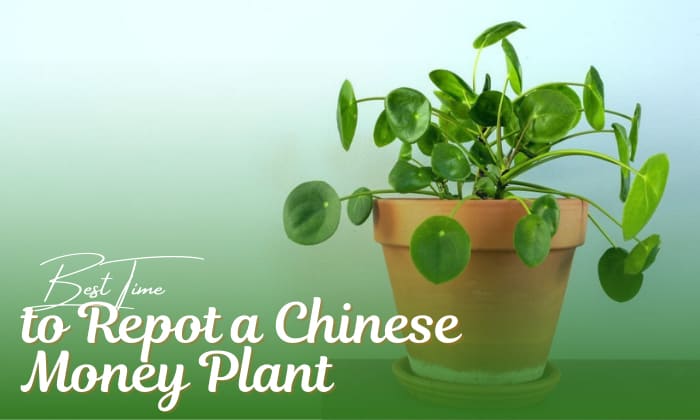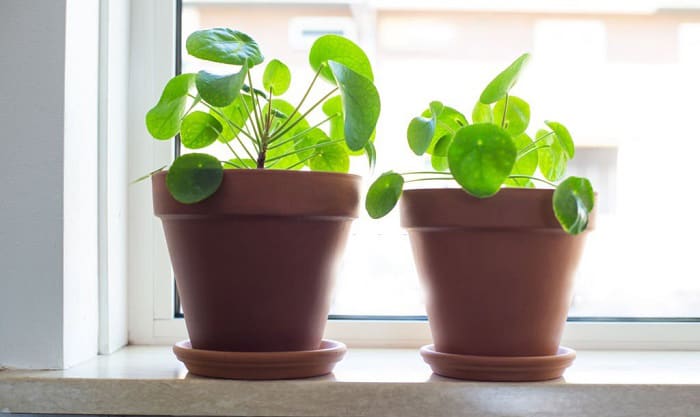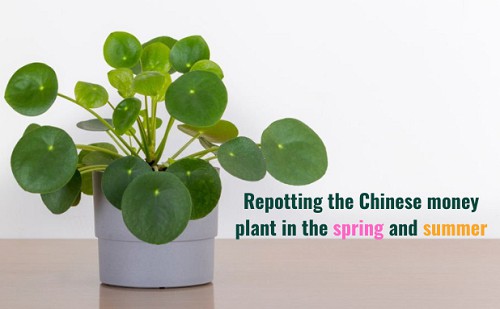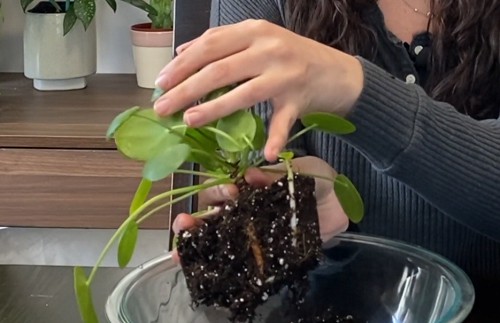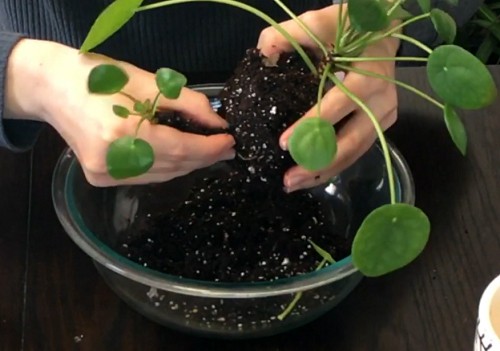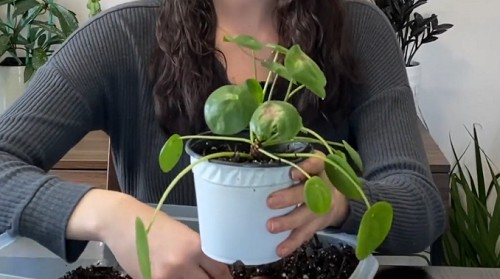Money penny plants are native to China and thought to represent or bring fortune to their owners, a reason they’re popular among feng shui practitioners. Though this plant type requires little maintenance, its upkeep involves replanting occasionally to maintain optimal health and a glossy appearance.
If you’re pondering when to repot a Chinese money plant, once every 18 months or two years is the standard.
Table of Contents
Best Time to Repot a Chinese Money Plant
It’s vital to know what money leaf plant you have to care for it properly.
A Chinese money plant differs from a Chinese money tree (Pachira aquatica), a jade plant (Crassula ovata), and any other flora that does not go by the name Pilea peperomioides.
If you look at your Pilea, you’ll notice its distinct round foliage that resembles a coin, which is why people often call it a Chinese coin plant. It originates from Yunnan and Sichuan in south China and is an evergreen perennial with high humidity and drought tolerance.
Though this species is straightforward to grow, replanting it every so often is necessary to ensure the plant has sufficient space to spread and healthy soil to get nutrients from. Here are some indicators your money plant requires a new container.
1. Signs it’s time to repot
- The roots are poking out of the soil or container base. They have formed a circular mass, and there is little to no soil in the pot.
- Your money plant consistently fails to absorb water and nutrients, leading to wilting and discoloration or stagnant development.
- Plant roots have become so big that they put pressure on and cracked the container.
- There is rot or disease in the soil and on the money plant, or the potting medium has aged and become infertile, compact, and hydrophobic.
2. Best time of year to repot
Spring and summer are the best seasons to repot a Pilea plant because the houseplant is active during these periods and can adapt to changes better.
Similar to an overgrown money tree, Pilea will be more susceptible to transplant shock if you move it during fall and winter.
Stick to repotting money plant in spring and summer only, unless your Pilea is gravely sick.
3. Repotting guide for Chinese money plant
Before repotting Chinese money plant, prepare a container one to three inches wider than what you are using. Any material among ceramic, plastic, or terracotta will do, but terracotta is ideal if you tend to go overboard with your watering.
We recommend picking a container with drain holes and a saucer to hold excess water, plus purchasing a cactus or succulent soil blend as your Chinese money plant soil.
If not, a soil mix recipe of one part pumice and four parts potting soil or loamy soil, peat moss, sand, and perlite in a 2:1:1:1 ratio should also work.
Provided you’ve prepared all these things, here are the detailed steps to Chinese money plant repotting.
Step 1. Remove the money plant from its container.
Water the money plant a day before transplant time. On the next day, turn the container upside down to grab the plant base and remove it from its position.
Try shaking the pot or sliding a blunt knife around the container edge if you have trouble with this step.
Step 2. Clean the plant and remove diseased roots.
Wash the plant roots under a faucet so that you can see them more clearly. Trim off all brown, dead roots with a pair of sanitized scissors and keep only healthy white sections intact.
You should use 70% rubbing alcohol to sanitize your scissors before and between cuts.
Step 3. Put the money plant in the new pot.
-
- Add a few inches of soil into your pot for Pilea peperomioides, then place the Pilea into it.
- Backfill the pot to cover the roots, but leave the top inch of the receptacle empty.
- Finish by patting the soil with your fingers before watering the plant mix until moisture drips into the container saucer. The potting medium should be damp but not soggy.
Care for a Chinese Money Plant
Money plant care is essential to help the houseplant adapt to its new environment. Lighting, watering, and temperature are all things you need to be mindful of.
First, put the plant somewhere with indirect sunlight and a temperature of 55 to 86℉ or 13 to 30℃. An east or west-facing location without strong winds and away from vents would be optimal, and you can use grow lights if it’s difficult to find a bright enough spot.
Second, water the soil every time it gets dry, about once a week or whenever you see the leaves wilt.
Help the money plant grow by fertilizing it every two weeks with liquid plant food, but not during its annual dormancy and three to six months after Pilea repotting. You should use a balanced fertilizer and dilute it before applying for the best results.
Satisfying all these nutritional, temperature, and light requirements is essential if you want to see your money plant flower.
Repotting tips
- Pilea peperomioides repotting is an effective way to propagate Chinese money plant. You only need to relocate Pilea babies to a new container once they reach two to three inches in height, since they are more mature at this stage and will likely survive on their own.
- Remove the babies or pups from the main plant by cutting at its stem base, then put the clippings in two inches-wide nursery pots with soil.
- Care for the clippings as you would the mother plant, and they should establish themselves within one month.
- Note that it’s vital to keep the roots of Chinese money plant babies intact when you remove them.
- As for money plant care indoor, a common mistake you should avoid is giving your plant too much light or water, since direct sunlight and soggy soil can create curly, bumpy leaves, and brown foliage.
Similarly, you can have too much of a good thing when it comes to feeding plants. A Pilea that receives excessive fertilizer will have brown, discolored leaves that look unattractive.
Frequently Asked Questions
How often to water Chinese money plant?
The standard recommendation for money plant watering is every two weeks during winter and once a week the rest of the time. You can check the top two inches of the soil and see if they’re dry before irrigating.
Does Pilea like to be root bound?
No. Pilea plants do not enjoy being root-bound. Owners should take care of Chinese money plant by moving them to a new container whenever the roots form a coil at the bottom and have no space to expand.
How often should I repot my Pilea peperomioides?
Once every two years is the general rule. You can also observe the plant and see if it’s sick, constricted, or otherwise weakened due to problems that don’t relate to your daily care.
If the watering, sunlight, temperature, etc., are all appropriate and your Pilea is still unhealthy, it may just need transplanting.
How long do Chinese money plants last?
Chinese money plants can live for ten to twenty years with attentive care. This is quite similar to a money tree (or Guiana chestnut) when money tree repotting is done in a timely manner.
How do I know if my Pilea is root bound?
Look for signs like circular roots, cracks on the container, and a plant that is hard to dislodge from its place in the pot.
Conclusion
Changing money plants’ containers is a piece of cake if you have experience with repotting money tree, considering the processes are pretty much identical for both ornamentals. We hope this article gave you useful tips on when to repot a Chinese money plant and steps to care for it. Thank you for reading.
Read more:

Hi, I am William – Floridayards’ digital content creator. My job is to find answers to all your concerns with thorough research and our team’s expert advice. I will also bring you honest reviews on the best products and equipment for raising your beautiful garden. Please look forward to our work!


